DeFi has just begun, and the future of finance will be decentralized and on-chain.
Author: Arthur Cheong & Eugene Yap
Translation: Deep Tide TechFlow
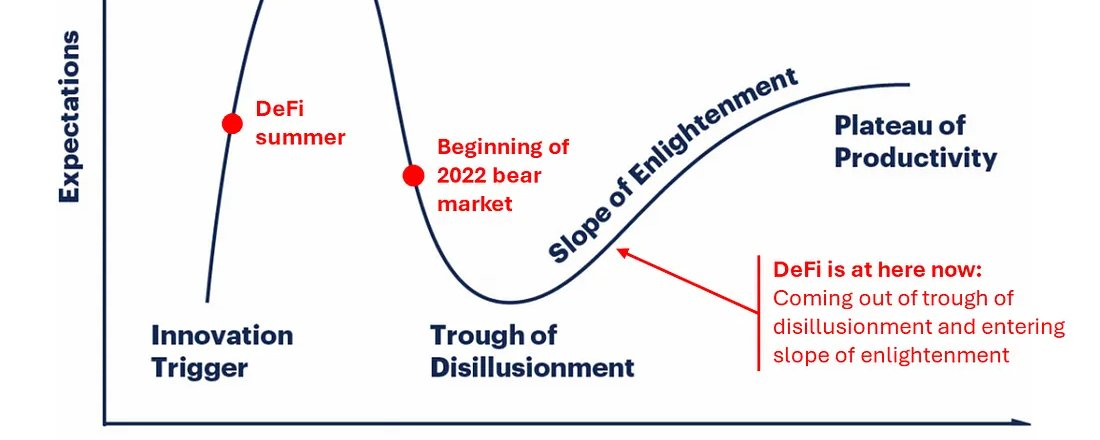
Starting from the 14th century, the European Renaissance sparked a revival of art, culture, and thought, profoundly changing modern civilization.
Today, we are witnessing a similar awakening in the cryptocurrency space—the Renaissance of decentralized finance (DeFi). Similar to the historical Renaissance, this movement is breaking down barriers and redefining our understanding of money and finance. With the power of blockchain and smart contracts, DeFi democratizes financial services, allowing global users to participate in a trustless economic system without relying on traditional financial intermediaries. It has the potential to revolutionize the financial industry.
Just as the European Renaissance relied on technological advancements and social changes, the DeFi Renaissance is also driven by several key factors that are helping it overcome early challenges and enter a new phase of growth and innovation.
1. DeFi is emerging from the valley of disillusionment
DeFi experienced rapid growth in 2020 and 2021, with many placing high hopes on it to transform traditional finance (TradFi). However, like most new technologies, the early hype led to disappointment as the infrastructure was not yet mature, resulting in a downturn in 2022.
However, like any revolutionary movement, DeFi has become more resilient and is emerging from the "valley of disillusionment," beginning to climb the "slope of enlightenment." The Gartner Hype Cycle is an effective framework to describe this process, and DeFi is currently showing signs of recovery.

After two years of adjustment, key metrics such as Total Value Locked (TVL) are rebounding, as shown in the chart below. While the rise in cryptocurrency asset prices has improved some metrics, the trading volume on DeFi platforms has also significantly increased, nearly returning to 2022 levels, proving the authenticity of the recovery.
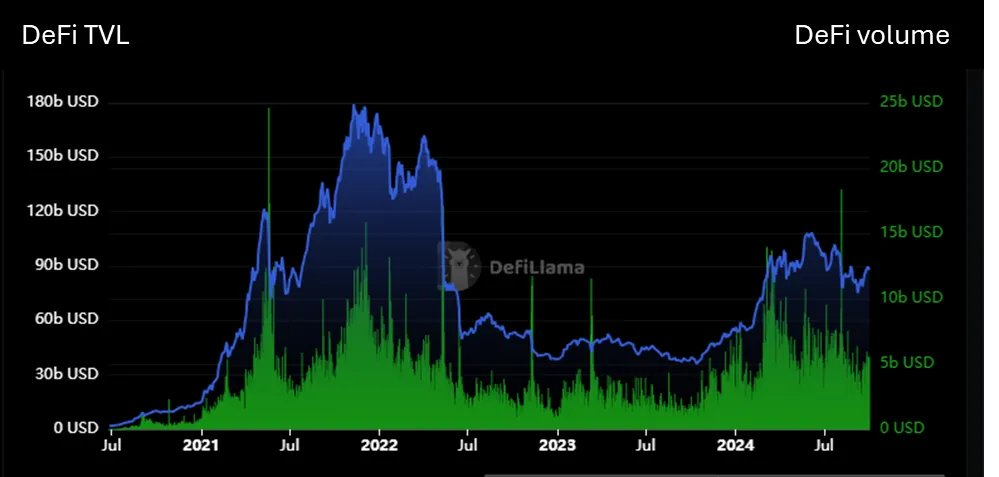
In fact, some core DeFi projects, such as Aave, have even surpassed their 2022 peaks on multiple metrics. For example, Aave's quarterly revenue has exceeded the levels of Q4 2021—the peak of the last bull market.
Our complete analysis of Aave can be found here.
This indicates that DeFi is gradually maturing and entering a new development phase, preparing for long-term scalability.
2. The new interest rate cycle will make DeFi returns more attractive
The recovery of DeFi is not only dependent on internal factors; external economic changes also play a crucial role. As global interest rates change, risk assets like cryptocurrencies, including DeFi, become more attractive to investors seeking higher returns.
With the Federal Reserve implementing a 50 basis point rate cut in September, the market may enter a low-interest-rate period, similar to the environment that drove the crypto bull markets in 2017 and 2020, as shown in the chart below. Bitcoin (and cryptocurrencies) bull markets typically occur in low-interest-rate environments (green areas), while bear markets often happen during periods of rising rates (red areas).
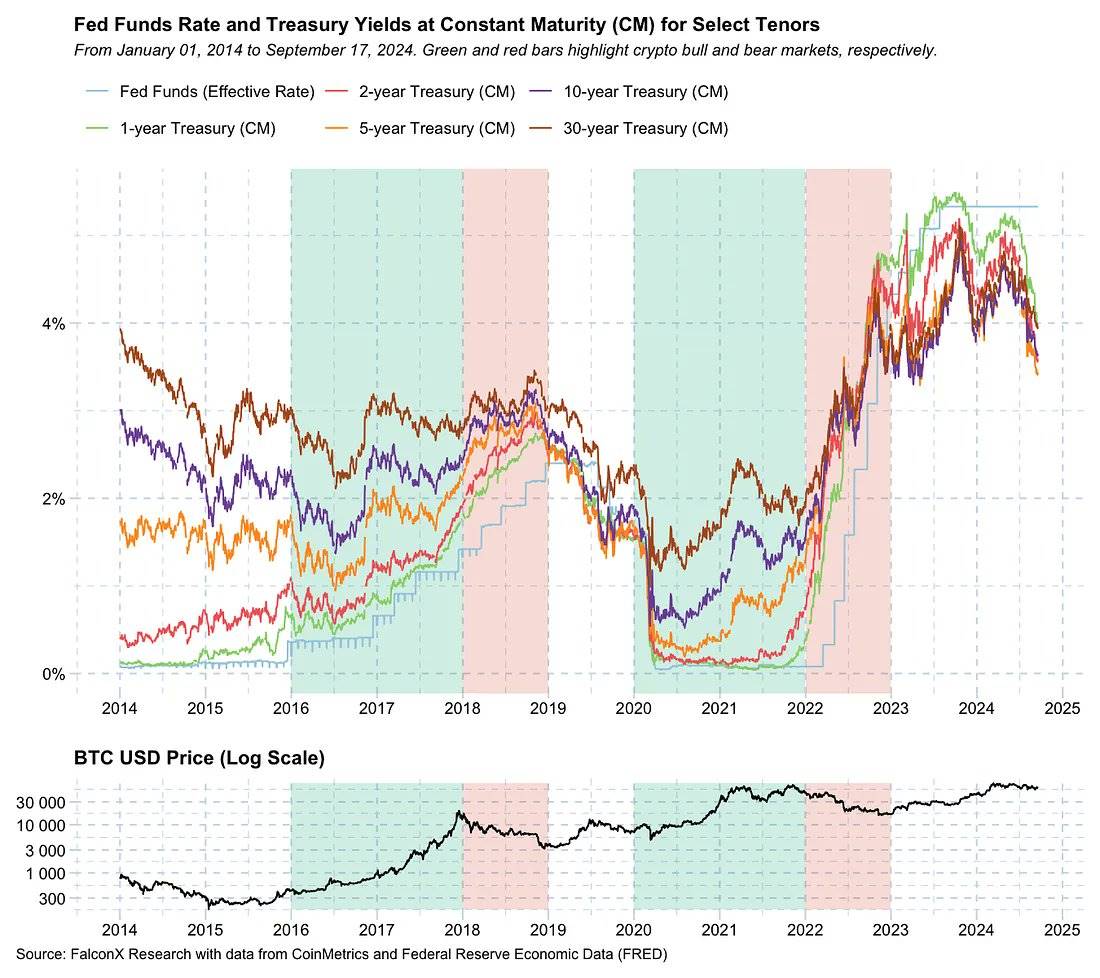
DeFi has two main benefits in a low-interest-rate environment:
Reduced opportunity cost of capital—As interest rates decline, the returns on treasury bills and traditional savings accounts decrease, prompting investors to turn to DeFi protocols to earn higher yields through yield farming, staking, and providing liquidity.
Lower borrowing costs—The decline in financing costs encourages DeFi users to borrow and use it for productive purposes, thereby boosting the overall activity of the ecosystem.
While interest rates may not return to near-zero levels seen in previous cycles, the opportunity cost of participating in DeFi will be significantly reduced. Even a moderate decline in interest rates can amplify the difference between rates and yields due to leverage, leading to significant impacts.
Additionally, we foresee that the new interest rate cycle will be an important driver for the growth of stablecoins, as it greatly reduces the capital costs for traditional financial funds to turn to DeFi in pursuit of yields.
In the previous cycle, the Federal Funds Rate (FFR) showed an inverse relationship with the growth of stablecoin supply, as illustrated in the chart below. With rates declining again, stablecoin supply is expected to increase, providing more "dry powder" for the accelerated development of DeFi.
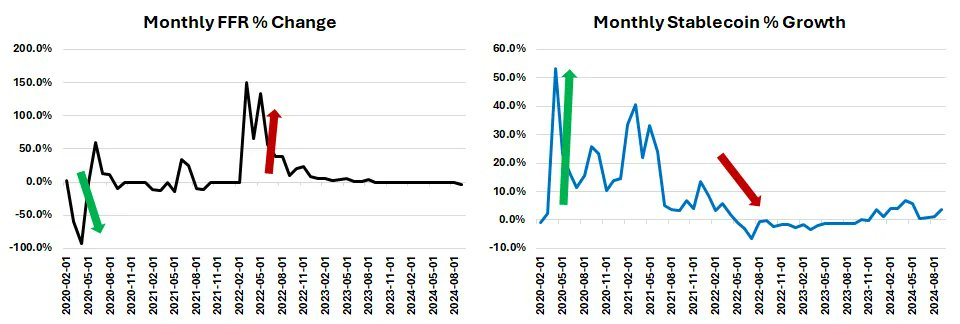
3. Finance: The largest product-market fit for cryptocurrencies
The crypto space has attempted various application scenarios, such as NFTs, the metaverse, gaming, and social media. However, from most objective metrics, they have yet to truly find product-market fit (PMF).
For instance, even with a brief resurgence of Bitcoin Ordinals in 2024, the daily trading volume of NFTs continues to decline.
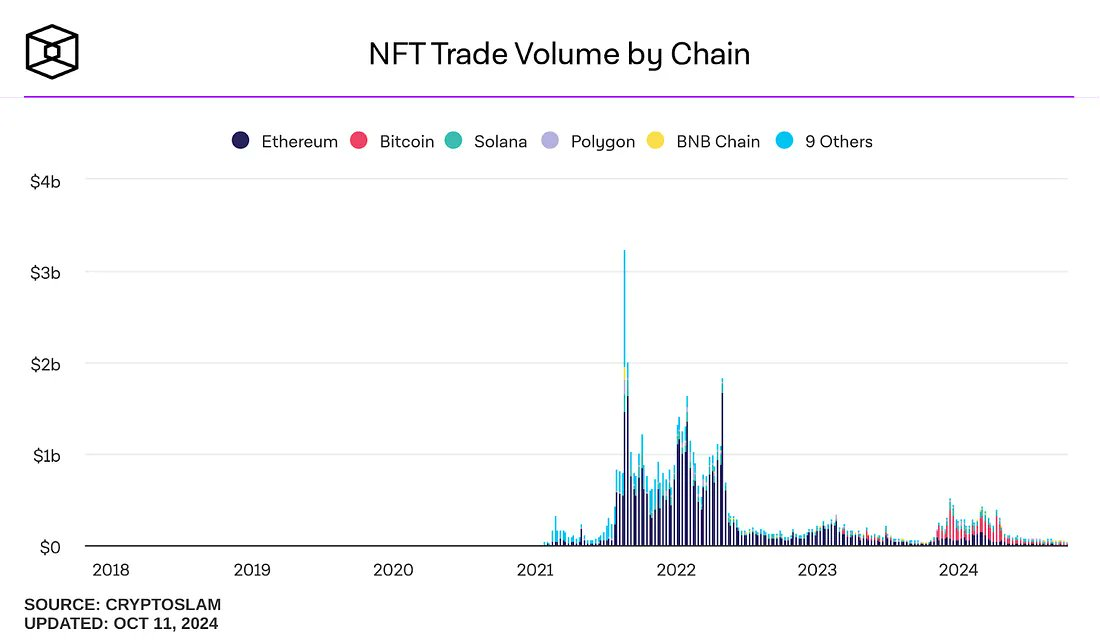
As for the metaverse and gaming sectors, there are currently no breakthrough Web3 games widely accepted by global fans. Two early Web3 metaverse projects, Decentraland and Sandbox, struggle to reach even a few thousand daily active users, while Roblox boasts daily active users of up to 80 million. Although the daily active users of TON games are impressive, it remains uncertain how many will continue to play on TON without more financial incentives.
In contrast, DeFi has proven its product-market fit. The growth of core DeFi categories, such as liquid staking and lending, has seen year-on-year growth exceeding 100%, demonstrating its appeal. At the same time, new billion-dollar categories, such as restaking (Eigenlayer) and base trading (Ethena), which had zero TVL a year ago, are now rapidly emerging. This explosive growth showcases the composability and permissionless nature of DeFi, where new financial "Legos" are built on top of each other to unlock new application scenarios.

Although regulatory barriers have long limited DeFi's potential to disrupt traditional finance, its inherent advantages are evident. For example:
The average cost of cross-border transactions and remittances is 6%, with transfers taking 3-5 business days.
The backend systems of stock exchanges are bloated and have limited operating hours, leading to inefficiencies.
Real-world assets, such as real estate, can release liquidity through tokenization and achieve composability in DeFi, for example, being used as collateral.
DeFi's 24/7 operation, low costs, high liquidity, and lack of intermediaries make it a more efficient choice. The technology is mature; the question is whether regulators will allow DeFi to disrupt this $100 trillion global financial industry that relies on inefficient operations.
To demonstrate how DeFi outperforms traditional finance (TradFi) in efficiency, we can compare the costs of operating services between the two. According to research from the International Monetary Fund (IMF), the analysis is as follows:
Labor costs: DeFi's labor costs are nearly 0%, while TradFi's labor costs range from 2-3%. For example, DeFi loans are processed automatically without human intervention, while TradFi requires manual review and paperwork.
Operating costs: DeFi's operating costs are only 0.1%, while TradFi's operating costs range from 2-4%. DeFi does not require large offices or intermediaries, as smart contracts can handle transactions, and the blockchain is responsible for verification. Overall, TradFi's marginal costs reach 6-8% in developed economies and 10-14% in emerging markets, costs that are ultimately borne by users.
DeFi eliminates these inefficiencies. It's that simple.
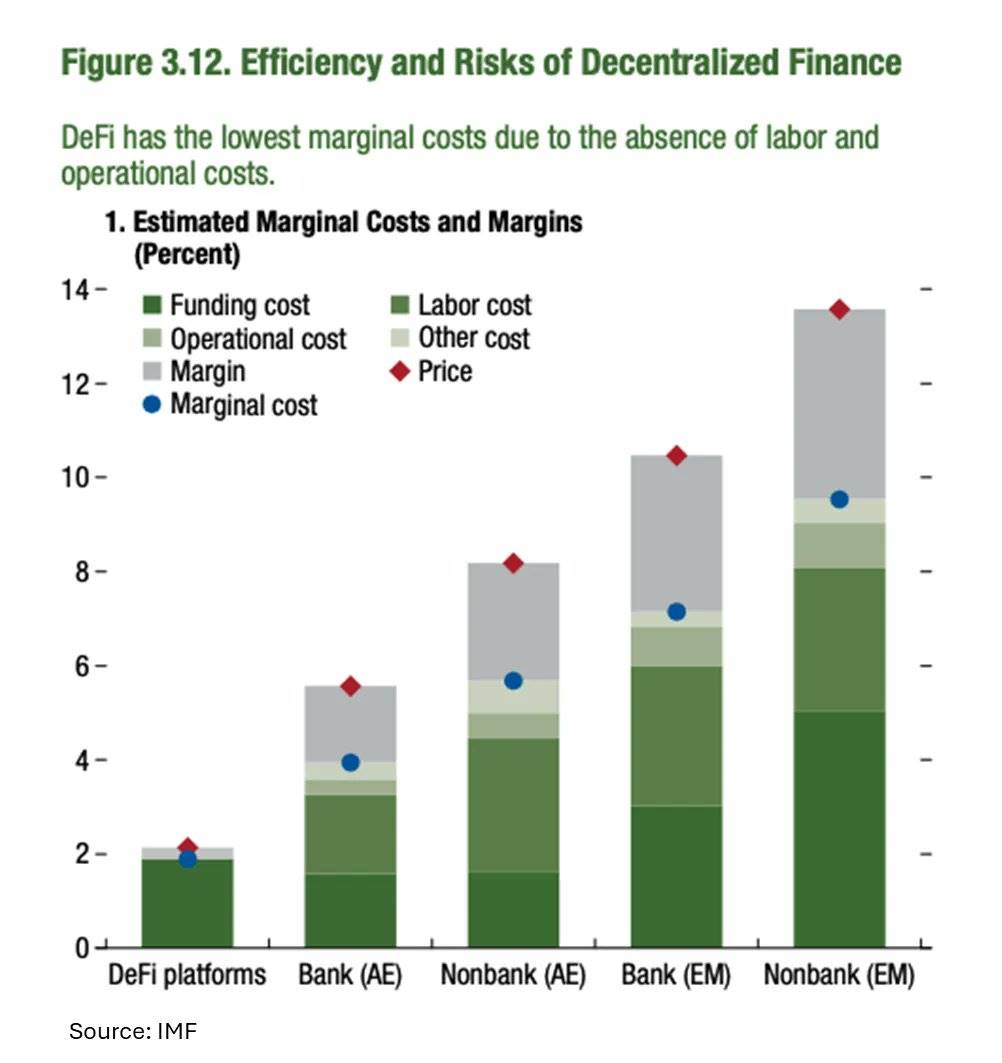
Moreover, the fintech industry has seen little innovation over the past 15 years, which aligns with findings from Blockchain Capital. Despite significant advancements in areas like AI and global internet access, fintech still relies on outdated systems, such as the SWIFT system that all banks have used for 50 years, with transfers typically taking 1-4 business days.
Most fintech advancements, such as digital payments, fractional shares, and APIs, primarily focus on improving user experience rather than addressing the core inefficiencies of traditional finance. For example, Robinhood and Plaid provide convenient stock purchasing solutions, but they still rely on old financial infrastructure. The real issue is that fintech merely connects to outdated systems to maximize utilization rather than creating entirely new systems. While these changes have been helpful, they have not resolved the deep-rooted issues plaguing the traditional financial world.
DeFi is different from traditional finance; it was designed for digitalization from the start. DeFi does not rely on old financial systems but integrates financial services directly into the internet. In DeFi, fractional shares, over-collateralized loans, and global payments are no longer innovations but basic functionalities. This marks a fundamental shift in how finance operates, from minor improvements to complete transformation.
By adopting DeFi, we can not only make slight adjustments but also unlock enormous new economic opportunities, improve financial accessibility, and create wealth in areas often overlooked by traditional finance. This means reshaping the financial system to operate better in the digital world.
Looking ahead, the 2024 U.S. elections may provide clearer regulatory direction. If Trump is elected, cryptocurrency-friendly policies may be implemented, while the Harris administration's recent positive stance towards the industry may also continue. Regardless of the political landscape, the momentum for DeFi's development is unstoppable.
DeFi has just begun, and the future of finance will be decentralized and on-chain.
4. Improved User Interface/User Experience, Infrastructure, and Security
In its early stages, DeFi was hindered by unfriendly interfaces and technical complexities that frustrated users. However, in the past few years, user experience, infrastructure, and security have significantly improved, making DeFi more accessible to mainstream users.
One of the most notable advancements is in wallet infrastructure. Managing seed phrases and private keys was a major barrier, but new smart wallets and embedded wallets have simplified and secured this process. Features such as social recovery, biometric authentication, and passwordless login now allow users to manage their funds more easily without the complex operations of traditional Web3 wallets.
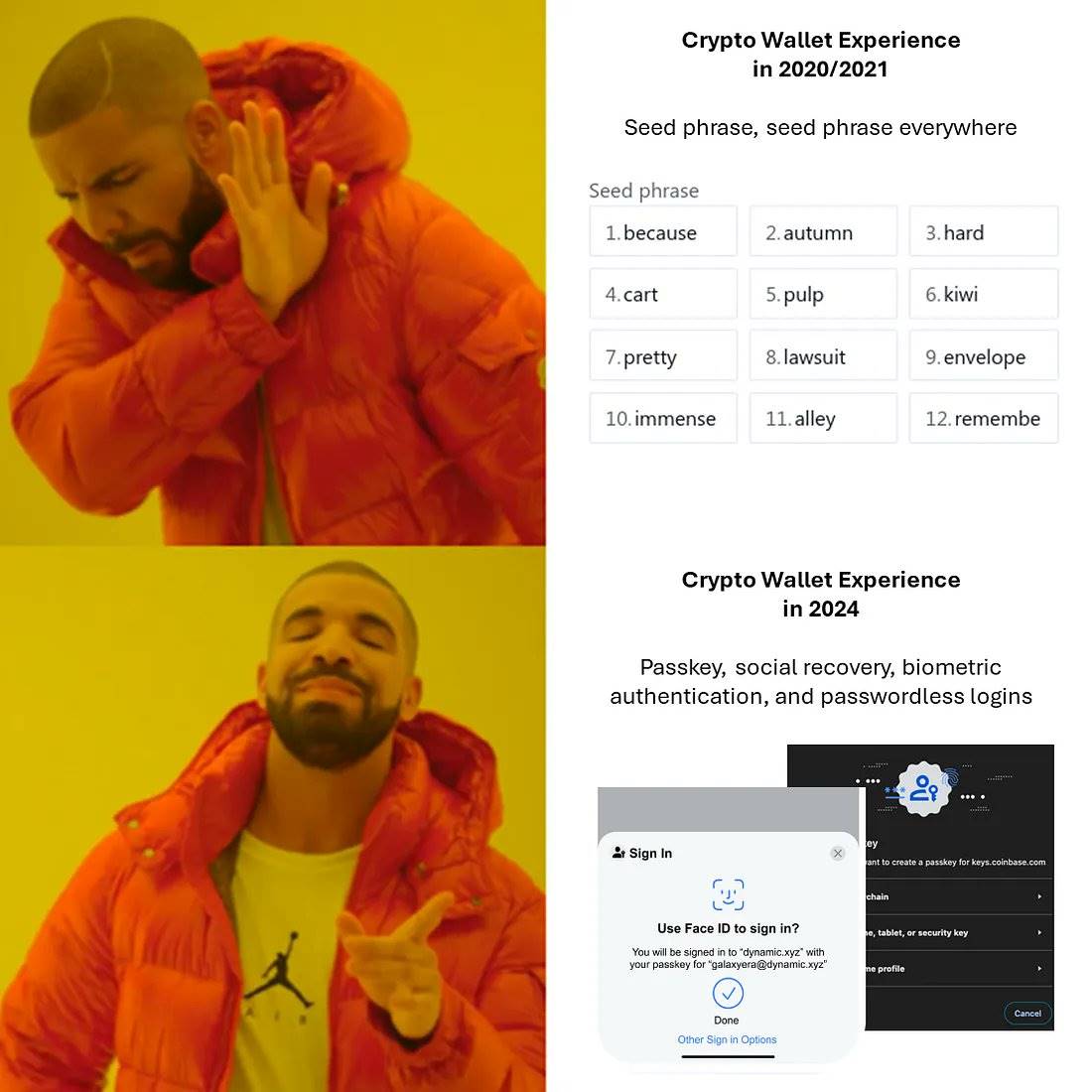
The security of DeFi has also seen significant improvements, with comprehensive smart contract audits before deployment becoming standard. Platforms like ImmuneFi encourage ethical hackers to identify vulnerabilities and security issues through bug bounty programs, ensuring these problems are addressed before they can be exploited. These advancements in wallet infrastructure and security have made DeFi safer and more efficient for all users. The number of DeFi hacking incidents has significantly decreased over the past year, a direct result of these improvements.
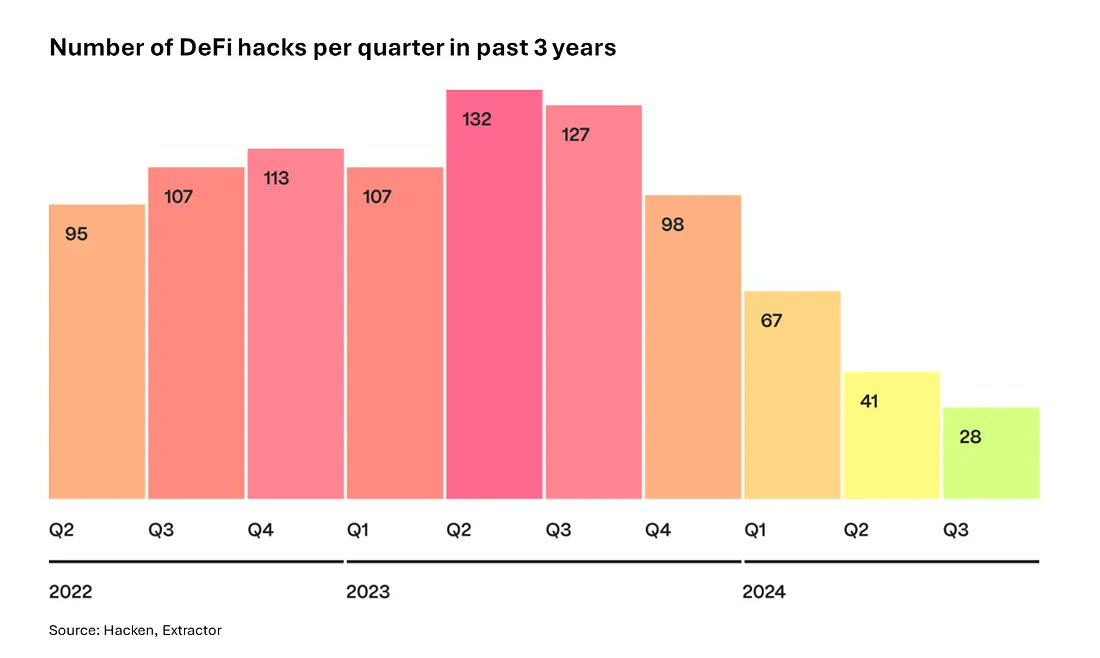
With these advancements, DeFi is gradually moving into the mainstream market, including adoption by institutions, driving its continued growth.
5. Make DeFi Great Again
Just as the European Renaissance reshaped society, DeFi is preparing to revolutionize the financial industry. DeFi has immense innovative potential, and we are just beginning to witness its impact. As more users and investors join DeFi, the future of global finance will increasingly shift on-chain, making financial systems more efficient, open, and accessible.
DeFi has the ability to eliminate inefficiencies, break down barriers, and create new opportunities for financial inclusion. This is not just a fleeting trend but a fundamental shift in how the world interacts with money. From global payments to widespread financial services, DeFi offers the possibility for anyone to participate in the financial system.
Currently, the total market capitalization of all DeFi protocols is approximately $33 billion, accounting for only 1.4% of the total cryptocurrency market cap of $2.3 trillion.
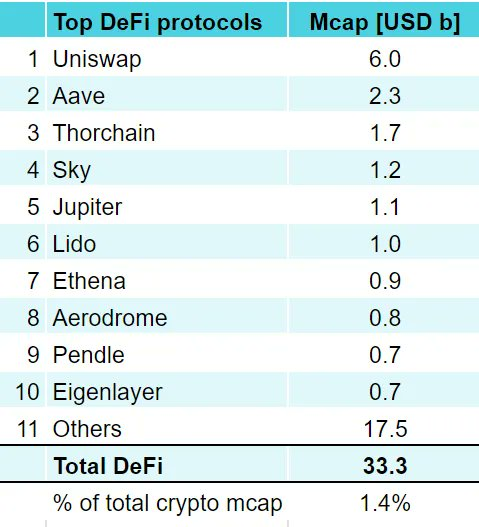
Figure: Data as of October 13, 2024
Despite challenging market conditions and industry environments, the growth and success of DeFi have recently been overlooked, but this will change. As DeFi protocols continue to evolve at an astonishing pace and return value to token holders, such as Aave's recent token economics proposal, market participants will place greater emphasis on the fundamentals and potential of DeFi and readjust their capital allocations.
We anticipate that as DeFi continues to expand and the market awakens to its new trends and potential, the share of DeFi assets in the total cryptocurrency market cap will grow from 1.4% to 10% over the next two years.
Make DeFi Great Again.
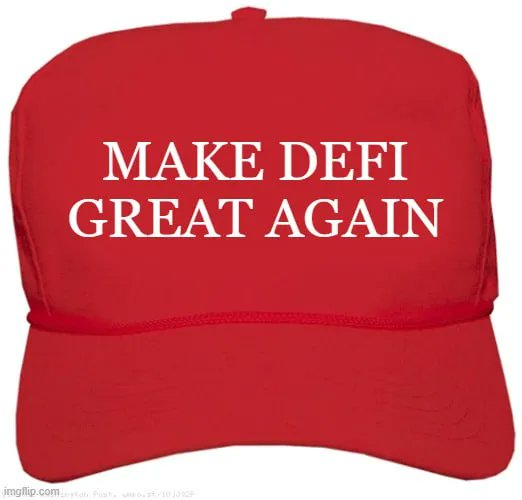
Acknowledgments
Promoters of the term "DeFi Renaissance"
Important Disclaimer: This document is for informational purposes only. The views expressed in this document do not constitute investment advice or recommendations. Recipients of this document should conduct thorough due diligence based on their specific financial situation, investment objectives, and risk tolerance (not covered in this document) before investing. This document does not constitute an offer or invitation to buy or sell any assets mentioned herein.
免责声明:本文章仅代表作者个人观点,不代表本平台的立场和观点。本文章仅供信息分享,不构成对任何人的任何投资建议。用户与作者之间的任何争议,与本平台无关。如网页中刊载的文章或图片涉及侵权,请提供相关的权利证明和身份证明发送邮件到support@aicoin.com,本平台相关工作人员将会进行核查。




